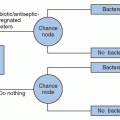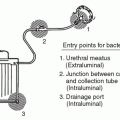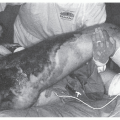after discharge from the nursery be reported to the infant’s nursery to facilitate prompt identification of an outbreak (e.g., skin infections associated with Staphylococcus aureus or Streptococcus group A or B, omphalitis, or bacterial diarrhea, especially Salmonella sp.) (12,15,16,17).
| |||||||||||||||||||||||||||||||||||||||||

Obtain at least 0.5 to 2 mL of blood for culture from two separate sites (preferably one peripheral site in patients with an intravascular catheter) (27,28,29,30,31,32,33).
Isolates detected within 24 to 36 hours of submission are more likely to be true pathogens. If blood cultures from an asymptomatic neonate who is being evaluated at birth owing to the presence of maternal risk factors remain negative at 36 hours, bacterial sepsis can be ruled out (32).
Sepsis is more likely when a clinical course or serial laboratory studies compatible with sepsis are documented (e.g., elevated absolute total neutrophil [ATN] or absolute total immature cell [ATI] counts, ratio of absolute total immature neutrophils to total neutrophils (I:T) >0.2 (34), and elevated C-reactive protein (35)). The likelihood of sepsis is <1% in the presence of three serial CBC and differential counts that remain normal over 36 hours.
True sepsis is more likely if the patient responds to antimicrobials that are active against the isolate, usually vancomycin for CONS and MRSA. Clinical improvement and/or failure to recover the same pathogen from repeat blood cultures when an infant is being treated with an antimicrobial agent that is not active against the pathogen casts doubt on the validity of that isolate as a true pathogen.
TABLE 26.2 Risk Factors for Healthcare-Associated Infections in Neonates | ||||||||||||||||||||||||||||||||||||||||||||||||||||||||||
|---|---|---|---|---|---|---|---|---|---|---|---|---|---|---|---|---|---|---|---|---|---|---|---|---|---|---|---|---|---|---|---|---|---|---|---|---|---|---|---|---|---|---|---|---|---|---|---|---|---|---|---|---|---|---|---|---|---|---|
| ||||||||||||||||||||||||||||||||||||||||||||||||||||||||||
countries where safe formula for bottle-feeding is readily available, breast-feeding is contraindicated for mothers known to be infected with HIV and HTLV-1. HBV vaccine given to neonates is protective against transmission by breast-feeding. Although cytomegalovirus (CMV) is transmitted in breast milk, maternal antibody is protective against clinically significant disease. The CDC’s guidelines developed for banking human milk obtained from unrelated donors include screening all donors for HIV, HTLV-1, and HBV surface antigen and pasteurization (62.5°C for 30 minutes) of all milk specimens. Bacterial counts of 104 colony-forming units (cfu)/mL or more of nonpathogenic organisms or the presence of gram-negative bacteria (GNB), S. aureus, or α- or β-hemolytic streptococci preclude the use of that milk (62). Established guidelines for human breast milk banks (www.hmbana.org), personal hygiene, and handling and decontaminating the components of breast milk pumps (62) should be followed.
NICU because the VLBW infant is at increased risk of developing disease after exposure.
Increased number and survival of VLBW infants.
Increased use of intravascular devices in the high-risk neonate.
Increased likelihood of identifying a blood culture positive for CONS as a true bacteremia with the use of more consistent definitions and methods of obtaining blood cultures (e.g., two blood cultures, preferably one from a CVC and one from a peripheral site).
reveal no other abnormalities but an echocardiogram could demonstrate vegetations in the right atrium or on the tricuspid valve. Removal of the CVC is required for clearance of CONS if BSI persists for >4 days (135).
Stay updated, free articles. Join our Telegram channel

Full access? Get Clinical Tree






